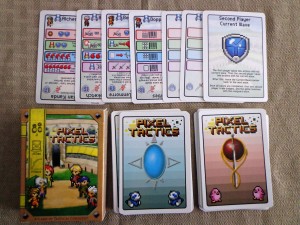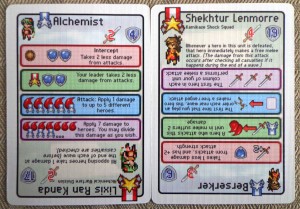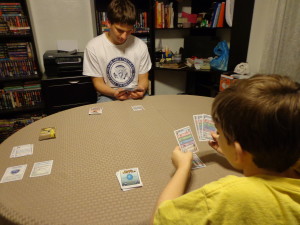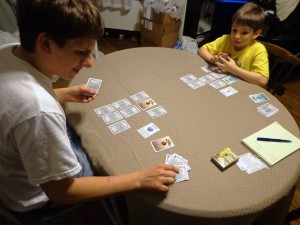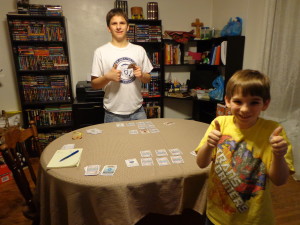“Pixel Tactics” is a two player card game with an eight-bit/sixteen-bit theme. Players will be summoning and using heroes to attack their opponent’s leader. The player who manages to kill their opponent’s leader first wins the game. Before we take a look at how this is accomplished, I’d like to thank Brad Talton from Level 99 Games for sending me a free review copy. While the game is still about a week away from being released to the general public, the pictures you’ll see in this article represent the final components.
Components
Decks – There are two identical, twenty-five card decks. Each card contains the identity of a hero (and possible leader) along with their abilities depending on their current location in the battle formation. Every card contains a hero and their abilities on one end, and a leader and their special ability on the other.
Life Counters – These counters are placed on cards as they take damage. It’s important to note that life counters are not included if you buy this game separately from the collector’s pack. My review copy was a separate product and thus didn’t come with life counters, so I opted to keep track of damage via paper and pen.
Game Board – While there is no game board, it’s important to note that the game requires enough space for a three by three grid in front of each player. The row closest to the player is the rear, the row in the middle is the flank, and the row furthest is the vanguard.
Setup & Gameplay
Each player receives a deck and shuffles it, drawing five cards for their hand. Both players choose a leader (the end of the card with the red colored ribbon and special ability) and at the same time, reveal them. They are placed in the center of the imaginary three by three grid, in the flank row. The object of the game is to kill the enemy leader before your opponent kills yours. The first player is chosen randomly.
The game is played over a series of waves, starting with the vanguard wave. During this wave, each player takes two actions before moving onto the next one. Once this has been done, both players repeat the process for the flank wave, and then finally the rear wave. Players will only be allowed to use / attack with the cards in a particular row, depending on what wave is being played at the time. After addressing all three waves, the player who went first yields the floor to the other player and lets them start the vanguard wave first.
During a wave, players will be able to perform two of the following actions:
1. Draw a card – The player draws a card from their deck. There are no hand limits.
2. Recruit a hero – The player plays a card from their hand onto the row of the wave currently being played. This gives the player a choice of three spaces, assuming all three spaces are empty.
3. Attack – The player can attack with a leader or hero, but there are some restrictions. Like recruiting, attacks can only take place from cards currently in the appropriate row / wave. Also, cards summoned on a turn cannot attack until the next time their wave comes around.
4. Play an order – Cards have a purple effect on them that can be played from a player’s hand. The effects of the card are followed, and the card is immediately discarded afterwards.
5. Clear a corpse – Cards defeated in battle stay face down on the battlefield, which serve to block new heroes from being summoned on that space until they are removed. This action clears a corpse from the battlefield.
6. Restructure – A player can move a hero from anywhere onto the row of the active wave, but cannot attack that turn. Leaders cannot be moved in this fashion.
The rules for combat are a bit complex to get into, but suffice it to say that heroes and leaders will be performing ranged and melee attacks, augmented by the cards around them. As cards take damage, hit counters are added to their card. Cards that exceed their hit counter limit are removed at the end of the wave, not immediately. This allows the soon to be dead hero / leader to take one last action or possibly save itself.
The above is simply an overview of the game, but should give you an idea of what you’d be in for. You can check out the rules in detail here:
http://www.lvl99games.com/wp-content/uploads/2012/09/Master-Rulebook.pdf
The Review
First, I want to extend my appreciation for the retro gamer art on the cards. As someone who grew up with an Atari 2600, NES, and SNES, I got more out of the artwork than the kids did…and yes, I realize that I’m dating myself. The text on the cards themselves were fairly easy to read, despite my bad eyesight. Like with any card game that involves multiple card types and effects, there is a bit of a learning curve. It may behoove players to look through their deck prior to playing, just so they can get a feel of what the cards do. In terms of quality, both the box and the cards are sturdy and well made. There are also two blank cards (one for each deck) so that players can create their own hero / leader…nice touch! I don’t like that the life counters aren’t included if you buy the game separately from the collector’s pack, as I’m relatively sure they’d fit alongside the game in the shipping box. I’m at a loss for ideas as far as retail copies go, however…but it’s worth mentioning for the benefit of paying customers.
In terms of strategy, there’s quite a bit going on. Since heroes have different actions based on what row they are currently in, players will have a lot to think about. They’ll have to consider what cards are currently on the battlefield, what wave the game is currently in, and what cards they currently have in their hand. Some heroes might be useless on the flank position one game, but be extremely helpful in that position in the next. It all comes down to how things look at the time, which can change from moment to moment and game to game. This gameplay mechanic offers some incredible replayability.
The kids really liked the combat aspect of the game, as they are heavy into Pokémon and Yu-Gi-Oh. They were much more comfortable linking cards to one another than I was. I find myself getting more and more overwhelmed by complex card mechanics as I get older, though I still enjoyed the time I spent playing the game with the kids…which is the entire point, is it not? At any rate, Vinnie (11) and Anthony (16) took the front seat this time around as I refereed. They definitely expressed an interest in playing the game again in the future, though I would need to be there if they did. Vinnie had a difficult time with the mechanics and the card effects, and I recommend that a parent be present to help coach as necessary. I was actually more useful on the sidelines as I was able to keep both kids in check.
Overall, “Pixel Tactics” is a great card game for those who aren’t afraid of a little reading and interpretation. With the right coaching, younger kids like Vinnie can play the game without too much of a problem. If your kids are already into card battling games, then they’d probably be able to jump right into this one. As I mentioned already though, the younger they are, the more likely they’ll need coaching. Since the game can be played in under an hour (even a half-hour), it is flexible enough to be played on a school night. The game is being sold for about $12.00 (as of 1/4/12), which I believe is a fair price all things considered. Casual card players that prefer something simpler may be put off by all of the different card effects, but those who enjoy card games that revolve around strategy and combat will more than likely enjoy this too.
Final Verdict: 6/10
—
You can learn more about and purchase “Pixel Tactics” by visiting the official site, here:
http://www.lvl99games.com/store/

